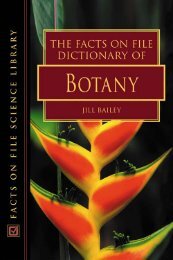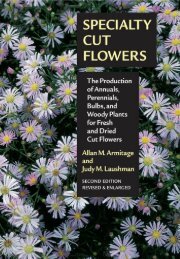You also want an ePaper? Increase the reach of your titles
YUMPU automatically turns print PDFs into web optimized ePapers that Google loves.
The stigma is the pollen receptor (1.32, 8.11);<br />
in wind-pollinated flowers the stigmas are often<br />
feather-like, while in other plants the stigmatic<br />
epidermis is either papillose or hairy (8.26). The<br />
majority of carpels possess a style (8.13 to 8.15)<br />
but in some species this is very short (1.31). In<br />
syncarpous species in which the styles are also<br />
fused, there is usually one main longitudinal vascular<br />
bundle per stylar component (8.13, 8.28).<br />
The centre of the style consists of transmitting<br />
tissue (8.28) and, after the pollen grains germinate<br />
(8.29), the pollen tubes grow downwards through<br />
this tissue towards the ovary (1.32), absorbing<br />
nutrients from this tissue en route (8.30).<br />
The ovules are attached to a thickened region<br />
of the ovary wall termed the placenta (1.32). The<br />
carpel is generally interpreted as a folded and<br />
modified leaf with its abaxial surface outermost;<br />
its margins are normally fused and typically twO<br />
longitudinal placentae lie internally (adaxially),<br />
close to the fused leaf margins (8.31). In syncarpous<br />
ovaries axile placentation is common,<br />
with the margins of the carpels fused at the centre<br />
of the ovary (1.6, 8.27). However, the placentae<br />
may also be located at the outer margin of the<br />
ovary (parietal placentation) or basally (8.4). In<br />
the apocarpous ovary marginal placentation is<br />
common (8.31).<br />
Each ovule is connected at its base (chalaza) to<br />
the placenta via the funiculus (1.32, fLU, 8.33).<br />
The ovule is invested by two (or sometimes one)<br />
thin integuments enclosing the nucellus. At the<br />
apical end of the ovule a narro\,,'" channel, the<br />
micropyle, penetrates the integuments (1.32) to<br />
expose the surface of the nucellus. The orientation<br />
of the ovule relative to the funiculus is variable<br />
but commonly the funiculus is bent through 180<br />
degress (anatropous ovule, 1.32, 8.33). The ovary<br />
walls and placentae are usually richly vasculated<br />
(8.31) and a number of smaller veins branch into<br />
the ovules (8.33) but vascular tissue rarely extends<br />
into the nucellus.<br />
Early in development of the ovule a megaspore<br />
mother cell becomes demarcated at the micropylar<br />
end of the nucellus (megasporangium, 8.34) and<br />
undergoes meiosis. In the commonest situation<br />
(Polygollllm, monosporic type) a vertical row of<br />
four haploid megaspores is formed. Only the<br />
deepest-sited (chalazal) cell develops further while<br />
the outer three megaspores degenerate (8.35). The<br />
single functional megaspore enlarges greatly<br />
\vithin the expanding nucellus and develops into<br />
the embryo sac (1.32, 8.33, 8.35). The original<br />
single haploid nucleus divides (8.35) to give the<br />
eight nuclei characteristic of the mature embryo<br />
sac (megagametophyte, 1.32).<br />
Other patterns of megaspore mother cell<br />
division also occur. In the bisporic type, one of the<br />
TWO derivatives of the first meiotic division<br />
undergoes further divisions and gives rise to the<br />
eight nuclei of the embryo sac while the other<br />
derivative degenerates. In tetrasporic development,<br />
the megaspore mother cell (8.34) undergoes<br />
meiosis but all four nuclei are confined within the<br />
common cytoplasm of the embryo sac. These<br />
nuclei then undergo a variahle number of mitoses,<br />
so that the mature embryo sac often contains<br />
more than eight nudei. In the semi-mature embtyo<br />
sac of Lilium (8.36) one haploid nucleus is located<br />
at the micropylar pole but the other three nuclei at<br />
the chalazaI end fuse to give a triploid nucleus.<br />
Subsequent mitoses and rearrangement of the<br />
nuclei lead to three haploid nuclei being situated<br />
at the micropylar end, one haploid plus one<br />
triploid nucleus in the centte of the embr>'o sac,<br />
and three triploid nuclei at the chalazal end.<br />
In the common monosporic type the eight<br />
nuclei and associated cytoplasm hecome separated<br />
by thin walls and ate located in various regions of<br />
the embryo sac (1.32). Three antipodal cells are<br />
located at the chalazaI end of the sac, two synergids<br />
and a median egg cell lie at the micropylar<br />
end \vhi1e the central region contains two polar<br />
nuclei within the endosperm mother cell. The egg<br />
cell is normally larger than the synergids; its<br />
nucleus and mOst cytoplasm usually lie towards<br />
the chalazal pole and here the wall is scantily<br />
developed. In the synergids, the cytoplasm is<br />
concentrated at their micropylar poles and their<br />
walls may be modified into a wall labyrinth<br />
(filiform apparatus) similar to that present in<br />
transfer cells (2.63). The synergids apparently<br />
transport nutrients from the nucellus to the egg<br />
and may form absorptive haustoria within this<br />
tissue. [n some species the synergids have a role in<br />
fertilisation. The antipodal cells commonly<br />
degenerate before fertilisation of the egg, but they<br />
may persist and also develop haustoria.<br />
Fertilisation<br />
When a compatible pollen grain is deposited on<br />
the stigma (1.32) a pollen tube grows out through<br />
one of the germination pores in the pollen grain<br />
wall (8.25) \...·here the exine is poorly developed.<br />
The cytoplasm and the nuclei migrate into the<br />
pollen tube which, after penetrating the stigma,<br />
grows downwards in the stylar transmission tissue<br />
(8.30).<br />
In the anther, the generative nucleus of the<br />
pollen grain may already have divided into two<br />
sperm nuclei; otherwise this occurs within the<br />
pollen tube (1.32). The nuclei and cytoplasm<br />
concentrate at the tip of the elongating pollen<br />
tube; behind this the tube is highly vacuolate and<br />
is often sealed off by plugs of calJose. The pollen<br />
147





